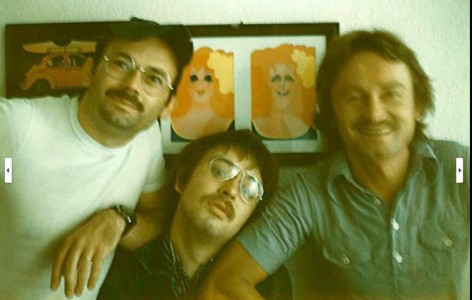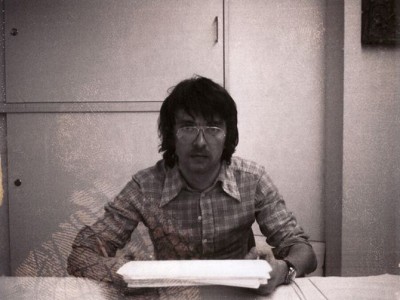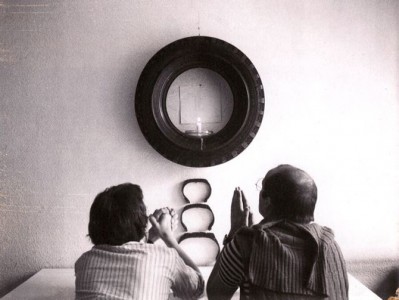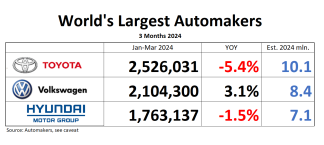1973, at the tender age of 24, I defected to the enemy. BS, the former muckraking journalist, became a copywriter in a hotshot advertising agency. As the saying went, I didn’t sell out, I cashed in: As a junior copywriter, I was paid twice as much of what I had made before as the editor in chief of a muckraking journal.
Raking muck had paid shit. Advertising was paradise. Work was easy, no more nerve-racking and downright dangerous undercover research, just sit and write. Powered by pilsener. Soon, my salary multiplied. Times were good. Until the world nearly ran out of gas …
They put me on the Volkswagen account. I didn’t have the vaguest idea about cars. I didn’t even have a driver’s license. This qualified me as an utterly unbiased and unbelievably gullible tool of automotive propaganda.
One of my first jobs was to launch a new Volkswagen with a funny name: “Golf.”
Everybody at Volkswagen hated that car. It had the wrong shape. At the time, a true Volkswagen was round. This thing was boxy with harsh corners. It had the wrong engine. A true Volkswagen was air-cooled, this one was cooled with—ughh—water. The engine was in the wrong spot. A true Volkswagen hat the engine in the rear, this one had it up front. It was designed by the wrong people. A true Volkswagen was designed by Volkswagen engineers. This one was engineered by people from Audi, that strange little Bavarian company Volkswagen had acquired from Mercedes a few years before.
Not that all that mattered to me. Frankly, I didn’t know the difference between air-cooled and water-cooled. Or between double wishbone and a chicken breast. But it had been impressed on me to listen to the client. And the client thought that water-cooled was an act against nature. The mere thought that this contraption would de-bug Volkswagen was regarded as insanity.
Everybody at Volkswagen was deeply convinced that the Golf would be an utter disaster. But they had no other choice. Attempts of their own engineers to make something else than the Bug, with the proper shape and the proper engine, had ended in even bigger disasters, again and again. Anybody remember the VW 411 or VW 412? Nobody? See?
The cupboard was bare, so they had to sell the ugly water-cooled duckling.
In late 1973, the first oil crisis hit. This didn’t instill additional confidence in my first client. The price of a barrel of oil jumped from $3 to the obscene level of $12. Everybody at VW was convinced that this would be the end of the car as we knew it, and that we would all be taking the (steam powered) train, or the bicycle. I began to wonder whether my career choice was sound. I began to suspect that I was put on the Volkswagen account because nobody else wanted it. My colleagues, who pushed cigarettes, hair coloring and Jägermeister, confirmed that suspicion.
There was a positive aspect to all of this: Nobody really cared, and everybody was convinced that the Volkswagenwerk Aktiengesellschaft (as VeeDub was named at the time) would soon be gone, along with all other car companies on the planet. This gave us free range, and we could do whatever came to our warped and alcohol-affected minds.
(Later, whenever oil spiked, the notion that cars and car companies would soon be dead returned with regularity. With the same regularity, the auto industry kept puttering along, reminding us of Mark Twain. The news of my demise, and all that . . . )
The campaign we created in late 1973 for the Golf showed the car on a spot of green. We placed a little flag next to it. The headline went: “The new popular sport: Golf.” (“Der neue Volkssport: Golf.”) At the time, golf was something for the super-rich in Germany. We thought it was uproarious. Nobody complained that the Golf wasn’t a sport scar. “Positioning” was something you did on the soccer field, or in corporate politics. It wasn’t part of the marketing arsenal, at least not at Volkswagen. Nobody admonished us that times were dire, and that word games with snooty sports were just wrong. Political correctness was invented later, long after the PC. Frankly, nobody gave a damn.
In March 1974, the first official Golf rolled past “Zählpunkt 8“ at the VW factory in Wolfsburg, and into the showrooms of doubtful dealers. Yet again, all predictions went out of the window: The Golf became a runaway hit.
Quickly, the Golf outsold all cars in all of Europe, a title which it defended well into the new millennium. In 2002, the Golf dethroned the Volkswagen Bug as the world’s best selling car. It was later ousted by the Ford F series truck, and the Corolla. The F truck’s success is widely repressed from consciousness, as it doesn’t jibe with current politics. The title of the Corolla is disputed as Japanese trickery.
A few years after the launch—a million was still a million—the Golf had turned a loss of 807 million Deutschmarks into a gain of 667 million. At the same time, the head of the ZAF, or the Zentrale Absatzförderung, as the Volkswagen Advertising Dept. was called, and I sat in the dining car of the train from Wolfsburg to Düsseldorf.
He wiped the König’s Pilsener froth off his mustache and announced:
“The Akademie Bad Harzburg asked me to present a case study of the success of the Golf.”
I was in awe. Die Akademie für Führungskräfte der Wirtschaft in Bad Harzburg was at the time THE breeding ground for future leading executives. Asked to give a presentation in Bad Harzburg was a high honor. It was the management equivalent to giving a seminar about rocket science at the Jet Propulsion Lab at Caltech. My guy had never been at an institution of higher learning. He had sold carpets, and then went to Ford, then to Volkswagen.
He was nervous.
“Can you help me write the darned thing?”
“Sure,” I said.
“So what are we going to say?”
Time for a beer for me.
“How about something unusual,” I offered.
“Such as?”
“The truth.”
“The TRUTH????”
“That’s right: Truth. We know, but they don’t: Nobody wanted the car. The car was wrong. Everybody hated it. To everybody’s surprise, it became a success.”
My man grunted admission. Then he went into deep thought.
He lit another cigarette and had another drink. One of the many of both he consumed every day.
“That’s a good idea. They really could learn something new,” he announced after thoughts, drink and cigarette were finished.
“A really good idea.”
In my mind, I already started writing. He lit and poured another one, then scratched an itch on his balding head.
“They would learn the most important ingredient of success: Luck, effing luck.”
I nodded furiously.
“But if I do that, I’ll get fired.”
The typewriter in my head made a last cling, and went silent.
And so it happened that, once more, students and faculty at the Akademie für Führungskräfte der Wirtschaft in Bad Harzburg were blatantly lied to.
They were told that after careful analysis of the market, after a study of the changing habits of the target group, with premonition of the rising oil prices, which everybody at VW had long seen coming, and with an enthusiastic cadre of engineers, the right car was made at the right time for the right price.
Due to the combined wisdom of everybody at Volkswagen, and the heroic effort of the Volkswagen workers, the Golf became a success, all according to plan.
For decades, the (official) version of the launch of the Golf was regarded as the textbook case of how to design, build, and market a car. The world was yet again deprived of an essential piece of wisdom:
Most big successes just happen to happen.
I was very sorry he lied, but I was very glad he kept his job. A decade and a half later, he became my partner in my own advertising agency. We continued doing the same old shtick: Advertising for Volkswagen. We made a lot of money.
The world really wasn’t ready for the truth.
This story from the SWWE (Stories We Wrote Elsewhere) archives appeared first on June 7, 2009 in Thetruthaboutcars.com









